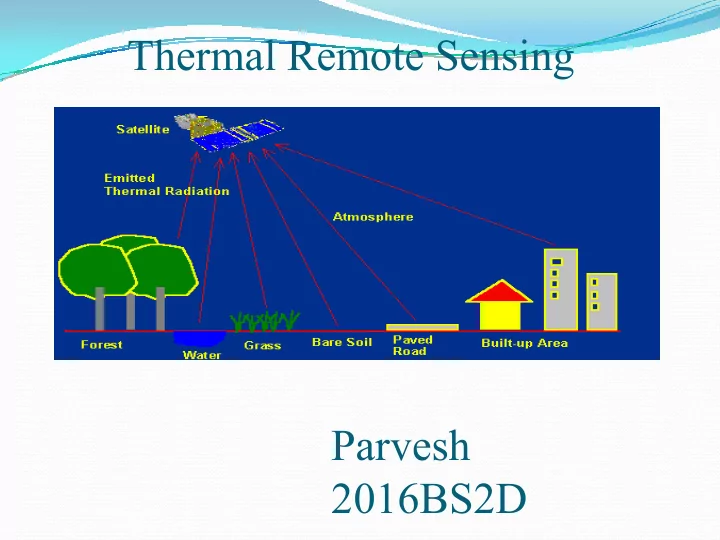

Thermal Remote Sensing Parvesh 2016BS2D
Thermal infrared of EM spectrum All objects have a temperature above absolute zero (0 K) emit EM energy (in 3.0-100 µm). Human being has normal 98.6 ºF (37 ºC) 100 m 100 m Our eyes are only sensitive to Our eyes are only sensitive to visible energy (0.4-0.7 µm). visible energy (0.4-0.7 µm). Human sense thermal energy through touch. while detectors (sensors) are sensitive to all EM spectrum. 3.0 m All objects (vegetation, soil, rock, water, concrete, etc) selectively absorb solar short- wavelength energy and radiate thermal infrared energy. 0.7 m
Thermal IR Remote Sensing Thermal infrared radiation refers to electromagnetic waves with a wavelength of between 3 and 20 micrometers. Most remote sensing applications make use of the 3 to 5 and 8 to 14 micrometer range (due to absorption to 5 and 8 to 14 micrometer range (due to absorption bands). The main difference between thermal infrared and near infrared is that thermal infrared is emitted energy, whereas the near infrared is reflected energy, similar to visible light.
Emitted Energy Optical remote sensing (visible and near-IR) Examine abilities of objects to reflect solar radiation Emissive remote sensing (mid-IR and microwave) Examine abilities of objects to absorb shortwave visible Examine abilities of objects to absorb shortwave visible and near-IR radiation and then to emit this energy at longer wavelengths
Thermal Infrared Spectrum Thermal IR Infrared (IR) waves: •Near IR:0.7 to 1.3 μm •Mid IR: 1.3 to 3 μm •Thermal IR: 3 to 14 μm
Atmospheric Effects Within a given window, the atmospheric intervention between a thermal sensor and the ground can modify the apparent level of radiation coming from the ground depending on the degree of atmospheric absorption, scatter, and emission at the time and place of sensing. Atmospheric absorption and scattering make signals Atmospheric absorption and scattering make signals appear colder than they are and atmospheric emission makes objects appear warmer Both effects are directly related to atmospheric path length, meteorological conditions and atmospheric constituents which vary with site, altitude, time and local weather conditions.
Atmospheric Transmission The windows normally used for aircraft platforms are in the 3-5 micron and 8-14 micron wavelength regions Spaceborne sensors commonly use windows between 3 and 4 micron and between 10.5-12.5 micron None of the windows transmits 100 % because water vapor and carbon dioxide absorb some of the energy across the spectrum and ozone absorbs energy in the 10.5-12.5 micron
Sun-Target-Sensor System Reflected Sun path radiance Emitted Emitted path radiance Transmitted Reflected Absorbed target radiance Emitted target radiance Incident Satellite electromagnetic sensors “see” reflected and emitted radiation
Electromagnetic Waves Wavelength/Frequency
Principles of Thermal Radiation The amount of radiation emitted by an object is determined primarily by its: internal temperature and emissivity Plank's Radiation Law for blackbodies gives the position of the peak and total Plank's Radiation Law for blackbodies gives the position of the peak and total spectral radiance (area under the curve) of an object as a function of its temperature E= Energy or total radiant exitance, W m -2 h = Placnk’s constant k = Boltzmann constant c = speed of light (constant) T = temperature (in K) λ = Wavelength
Developments from Planck’s Law Wien’s Displacement Law Notice that the peak of the Blackbody curve shirts to shorter wavelengths as temperature increases temperature increases This peak represents the wavelength of maximum emittance (λ max )
Wien’s Displacement Law As the temperature of an object increases, the total amount of radiant energy (area under the curve, in W/m 2 ) increases and the wavelengths at which the objects emits the most energy decreases. To determine this peak wavelength (λmax) for a blackbody: λmax = A/T λmax = A/T where A is a constant (2898 μm K) and T is the temperature in Kelvins. The 300 K Earth’s peak emmittance wavelength is: 2898 / 300 = 9.7 μm, in the thermal IR What wavelength is the Sun’s radaint energy peak (6000 K)?
Developments from Planck’s Law Stefan-Boltzmann Law The Stefan-Boltzmann law is derived by integrating the Planck function with respect to wavelength: Stefan-Boltzmann Law: the amount of energy emitted E = σT 4 from an object is primarily a function of its temperature. σ is called the Stefan- σ is called the Stefan- Boltzmann constant. σ = 5.667 x 10 -8 Energy or the radiant flux (rate of flow of EM energy) Conclusion: Thermal IR: 3 to 14 μm Thermal Remote Sensing explained by three law’s Plank’s Radiations law Wein Displacement law derived from Plank’s law Stefan-Boltzmann Law
Recommend
More recommend